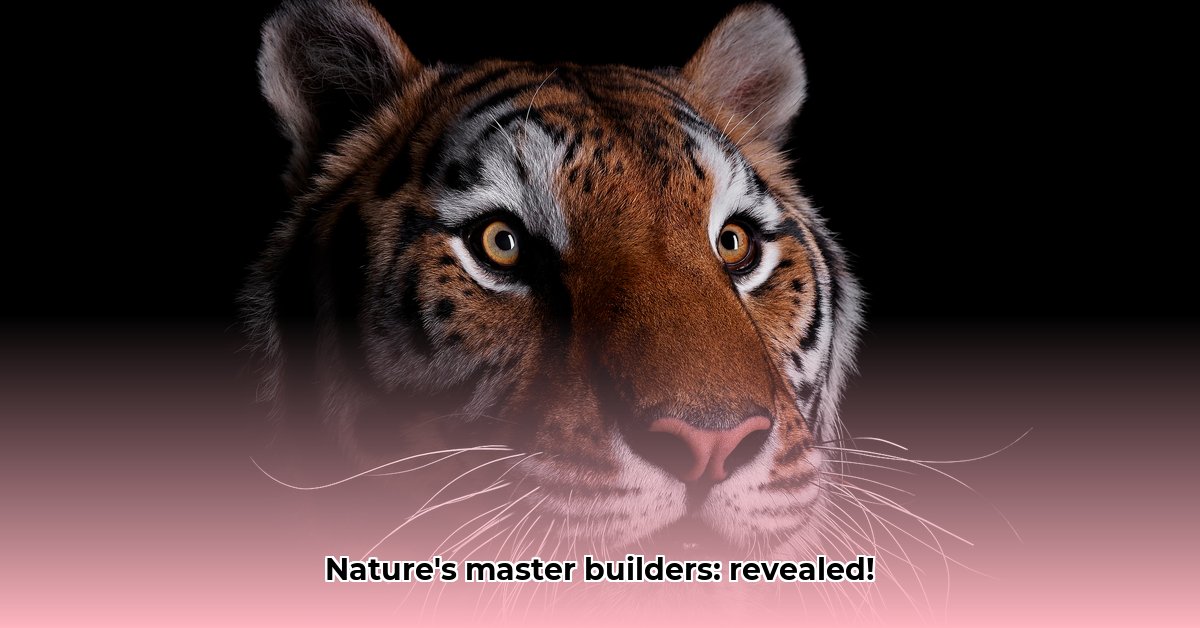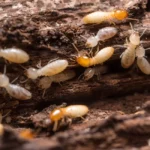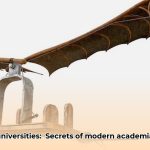Ever been awestruck by the intricate homes of animals, built without blueprints or heavy machinery? These creatures are master builders, fueled by instinct, teamwork, and resourcefulness! Envision beavers reshaping rivers with their dams, termites erecting air-conditioned mounds, and ants constructing sprawling underground cities. It’s a realm of awe-inspiring architecture, hidden in plain sight! This article dives into the stunning building feats of animals like beavers, termites, and ants, revealing their solutions to incredible engineering challenges. Discover how they’ve mastered sustainable building and how their innovations inspire us to create better homes for the future. Prepare to be captivated by nature’s most ingenious architects!
Unveiling Animal Architecture: Engineering Marvels in the Wild
Step into a world where tiny creatures, devoid of blueprints or power tools, construct marvels that mirror human engineering feats. This isn’t fantasy – it’s the captivating reality of animal architecture. From the sophisticated dams of beavers to the climate-controlled mounds of termites, the animal kingdom is brimming with impressive builders whose ingenuity constantly amazes scientists and inspires engineers. Let’s explore some remarkable examples of these natural architects.
Beaver Dam Builders: The Hydropower & Habitat Creators
Beavers, the semi-aquatic rodents celebrated for their gnawing skills, are legendary architects of aquatic habitats. Their dams are not simply haphazard piles of sticks and mud; they’re elaborate structures designed for both safety and survival, created with readily available materials. Beavers meticulously select materials—branches, stones, mud—to construct dams that can withstand powerful currents and create ponds. These ponds provide crucial habitat for wildlife, offering protection from predators and a reliable food source. The dams themselves are incredibly effective at altering water flow, often creating wetlands that benefit numerous other species. Scientists are still deciphering the intricacies of their dam-building techniques, noting how beavers appear to anticipate water pressure and adjust their designs accordingly. The scale of their projects, relative to their size, is truly astonishing! For example, a beaver dam in Alberta, Canada, stretches over 2,790 feet, visible even from space.
Termite Towers: Bio-Architecture & Climate Control
Journey to warmer climates to meet the termite architects and explore their mound construction. These social insects build massive mounds that are far more than mere homes; they’re intricate climate-control systems. These towering structures, often several meters high, maintain remarkably stable internal temperature and humidity, irrespective of the external environment. How do they achieve this natural climate control? Through a finely tuned system of ventilation shafts and porous walls that regulate airflow and prevent overheating. Various termite species have evolved different mound designs based on their environments; some are tall and thin, while others are sprawling and broad. Researchers are actively studying these systems, hoping to apply their principles to more sustainable building designs for humans that mimic termite mound ventilation. These intricate structures may unlock the secret to eco-friendly air conditioning!
Ant Colonies: Underground Megacities & Social Organization
Envision a vast underground city, complete with intricate networks of tunnels, nurseries, and waste disposal chambers. That’s the reality of an ant colony. These remarkable structures showcase a stunning level of collective intelligence and cooperation. Each ant plays a vital role, working tirelessly to maintain the complex system. From the queen laying eggs to worker ants foraging for food and soldiers defending the colony, amazing levels of coordination are displayed. Scientists are still exploring the complexity of ant communication and its role in coordinating construction. How do millions of ants manage to build such intricate structures without a central planner? The answer likely lies in a combination of simple rules and self-organization. Leafcutter ants, for instance, cultivate fungi in subterranean gardens, demonstrating their sophisticated agricultural practices within their complex social structure.
Bowerbird Boudoirs: Artful Architecture & Evolutionary Behavior
Consider a different kind of animal architect: the bowerbird. Unlike beavers and termites, bowerbirds don’t build for survival; they build to attract mates. Male bowerbirds construct elaborate structures, or “bowers,” which they decorate with colorful objects to impress potential partners. The complexity and artistry of these bowers vary greatly depending on the species, ranging from simple scrapes on the ground to intricate structures adorned with feathers, flowers, and even shiny bits of trash. The aesthetic sense demonstrated by these birds is remarkable; they seem to understand what makes a structure visually appealing. The bowers aren’t just decorative; they’re a testament to the male’s ability to gather resources and showcase his fitness to females. Great bowerbirds even create optical illusions by arranging objects from smallest to largest, creating a forced perspective.
Comparing the Creations: Diverse Strategies & Adaptability
While it’s difficult to directly compare the “efficiency” of a beaver dam to a termite mound using precise metrics (the data is complex and varies across environments), the diversity of approaches is striking. Beavers employ rapid construction with readily available materials. Termites meticulously build over time with precisely selected materials. Ants create underground megacities with superb organization. Bowerbirds focus on visual appeal. Each structure is a masterpiece of engineering, perfectly adapted to each species’ needs. This diversity highlights the incredible adaptability of evolution. Consider also the sociable weaver birds of southern Africa, which construct massive communal nests that can house over 100 breeding pairs, showcasing the power of cooperation in architecture.
Biomimicry: Nature as Architectural Inspiration
The ingenious designs of animal architects provide invaluable inspiration for human endeavors. Engineers are actively exploring biomimicry—mimicking nature’s designs—to create more sustainable and efficient structures. The ventilation systems of termite mounds, for instance, are being studied as a model for energy-efficient buildings. The strength and flexibility of spider silk are inspiring new materials for construction and protective gear. The possibilities are endless. The Eastgate Centre in Harare, Zimbabwe, successfully emulates termite mound ventilation, achieving significant energy savings.
Conservation: Protecting Ecosystems & Animal Architects
As we learn about the impressive capabilities of animal architects, we must also recognize the importance of habitat conservation. Many of these animals face threats due to habitat loss and climate change. Protecting their environments is crucial for their survival and for preserving the biodiversity these remarkable creatures support. The intricate structures they build are vital parts of their ecosystems; their destruction has far-reaching consequences. Active conservation efforts are vital to ensure future generations can marvel at nature’s ingenious designs.
A Lasting Impression: The Future of Animal Architecture Exploration
Exploring the world of animal architects reveals a breathtaking tapestry of ingenuity and adaptation. These structures are more than just homes; they are testaments to the power of natural selection, the beauty of evolution, and the surprising capabilities of creatures far different from ourselves. Their remarkable constructions continually challenge and inspire scientists and engineers alike, reminding us of the boundless creativity found in the natural world. Further research into these fascinating subjects promises even more astonishing discoveries and inspiring applications.
Comparing Energy Efficiency: Beaver Dams vs. Termite Mounds
Key Takeaways:
- Animal architecture showcases remarkable evolutionary adaptations, offering bio-inspired design and green solutions.
- Structures facilitate protection, ecological engineering, social complexity that lead to robust ecosystems.
- Instinct and simple rules govern construction, showcasing building systems and ecological roles.
Nature’s Master Builders: Diverse Architects & Engineering
Animal architecture offers countless examples of remarkable engineering, from termite mounds to beaver dams, so how do they compare? The intricate labyrinths of termite mounds and the impressive water management of beaver dams both demonstrate nature’s remarkable engineering prowess, but comparing them demands a multifaceted analysis.
Case Study 1: The Beaver’s Dam – A Hydrological Marvel
Beavers are famous for their dams. They meticulously select branches, mud, and stones, creating structures that alter entire landscapes. Their dams create ponds that provide protection from predators and access to food sources. But how efficient are these dams energetically? The energy expenditure involves material acquisition, construction, and maintenance against river flows. For example, beavers can fell trees many times their size, requiring significant energy output.
Case Study 2: The Termite Mound – A Ventilation System
Termite mounds stand as testaments to collective effort. Millions of termites work together, creating towering structures with complex internal ventilation systems. These regulate temperature and humidity, creating a stable environment for the colony. How does the energy investment in material gathering, construction, and maintenance compare to beaver dams? Termites build grain by grain, transporting soil, saliva, and feces, which requires a coordinated effort across the colony.
Comparing the Uncomparable: Challenges in Analysis
Directly comparing the energy efficiency of beaver dams and termite mounds presents significant challenges. The energy requirements of each species are impacted by variables. The energy cost of transporting materials varies greatly based on weight and distance. The longevity of the structures also plays a role; a long-lasting dam requires less energy invested over time than a frequently repaired one.
The Role of Materials & Construction Techniques
The choice of building materials impacts energy expenditure. Beavers mostly use readily available wood and mud. Termites use soil particles, saliva, and fecal matter. Both create incredibly strong structures, but the energy costs associated with collecting and processing these materials differ significantly. Termites and beavers exhibit different construction techniques, potentially influencing the overall energy efficiency.
Biomimicry: Learning from Nature’s Architects
Animal architecture holds enormous potential for biomimicry. Studying the ventilation systems of termite mounds could inspire efficient building designs. Beavers’ dam-building skills could inform new flood control strategies. By understanding how these animals build and maintain their structures, we can develop more sustainable solutions for human architecture.
Future-Proofing Biomimicry: Sustainable Building Materials & Green Solutions
Key Takeaways:
- Biomimicry offers a sustainable architecture approach that integrates functional principles.
- Nature provides solutions for thermal regulation, structural optimization, and material efficiency.
- The Eastgate Centre exemplifies biomimetic design, saving energy through termite mound ventilation.
Nature’s Master Builders: Architectural Strategies
Consider the intricate homes crafted by animals. Beavers, with their meticulous dams, and termites, with their towering mounds, are remarkable architects. Studying these structures offers essential lessons for human architectural design.
Beavers: Hydro-Engineering Experts
Beaver dams aren’t random piles of sticks; they’re strategically placed structures that regulate water flow. They select materials like mud and wood precisely. Their construction methods are ingenious, creating intricate systems of channels and ponds. The resulting environment supports a ecosystem. What can we learn from their sophisticated water management and materials?
Termites: Climate Control Champions
Termite mounds aren’t just homes; they’re advanced climate-control systems. These structures maintain stable internal temperature and humidity through ventilation systems. Can we replicate their ventilation techniques in our buildings? The Eastgate Centre in Harare, Zimbabwe, demonstrates the success of such biomimicry. This building uses a ventilation system inspired by termite mounds, resulting in significant energy savings.
Ants: Cooperative Construction
Ant colonies represent cooperative construction. They build elaborate tunnels and chambers. Their use of readily available materials is efficient. This sophisticated organization provides a model for collaborative construction.
Bowerbirds: Architects of Attraction
Bowerbirds create elaborate structures known as bowers. These intricate nests are meant to attract females. The design and decoration differ enormously between species. What can we learn from creativity’s role in their architecture?
Material Science Lessons
Nature provides sustainable building materials. Consider the strength of spider silk, the lightweight construction of bird nests, or the water resistance of termite mound walls. These structures demonstrate the potential of natural materials for construction.
Bridging Nature & Architecture
The success of biomimicry relies on interdisciplinary collaboration. Architects, biologists, engineers, and materials scientists must work together. Advanced technologies, such as 3D printing and computational modeling, can play a vital role.
Mastering Animal Architecture: Step-by-Step Guide
Key Takeaways:
- Animal architecture demonstrates diversity, ingenuity, and architectural prowess.
- Structures serve protection, resource gathering, social organization, and communication.
- Material choices and building techniques adapt to available resources in the ecosystems.
The Wonders of Animal Engineering
Have you ever marveled at a honeycomb or a beaver dam? These aren’t random piles of materials; they’re feats of engineering and testaments to the architectural prowess of the animal kingdom. Mastering Animal Architecture begins with recognizing the variety and function of these structures.
Diverse Architectural Strategies
Let’s explore animal builders and construction planning. Beavers construct dams that alter ecosystems and complex climate systems. Termites display impressive collective behavior. Ants, too, display impressive collective behavior when constructing intricate nests. Bowerbirds create displays that showcase their skills.
Material Matters & Methods
The materials used are diverse. Some employ readily available materials, like sticks and mud. Others utilize endogenous materials, such as silk (spiders) and wax (bees).
Social Structures & Architectural Complexity
A correlation exists between social complexity and architectural sophistication. Eusocial insects, like termites and ants, produce intricate structures. Their complex societies and elaborate architecture appear to have coevolved, each reinforcing the other.
Biomimicry
The ingenuity of these animal architects has inspired biomimicry. Imagine buildings inspired by termite mounds for ventilation, or self-assembling materials mimicking a spider’s web. These advancements promise sustainable solutions.
Conservation
Sadly, many habitats crucial for these animal architects are threatened. Protecting these environments is paramount.
1 Wilson, E. O. (2013). The social conquest of earth. Liveright.
- Understand the Dunning-Kruger Effect: Why Incompetent People Think They’re Experts: Gain Self-Awareness - August 1, 2025
- Ignaz Semmelweis: The Doctor Fired for Handwashing: A Public Health Tragedy - August 1, 2025
- Unlock Your Memory: Spaced Repetition: The Scientific Trick to Remembering Information Forever: Learn Effortlessly - August 1, 2025
















